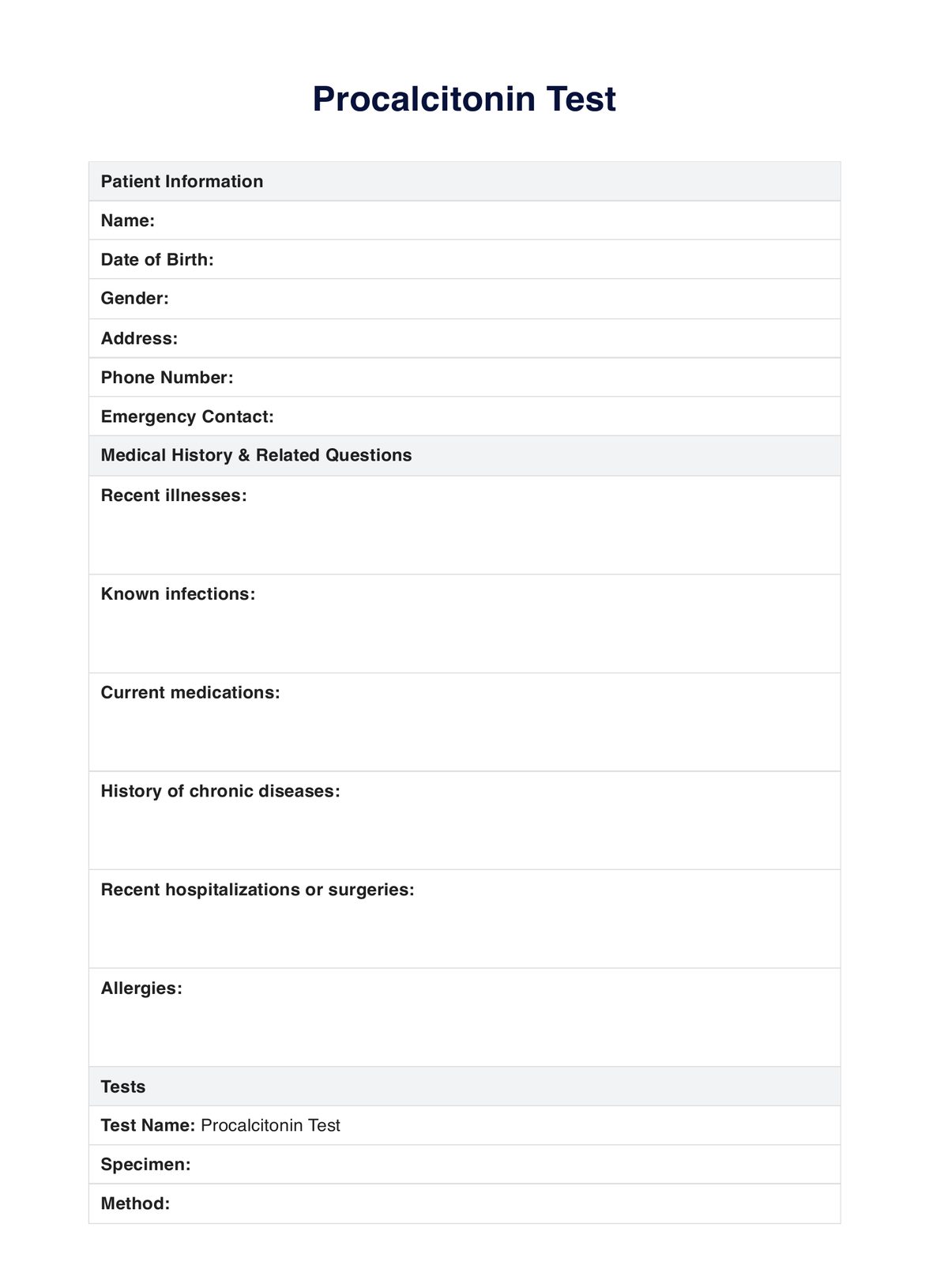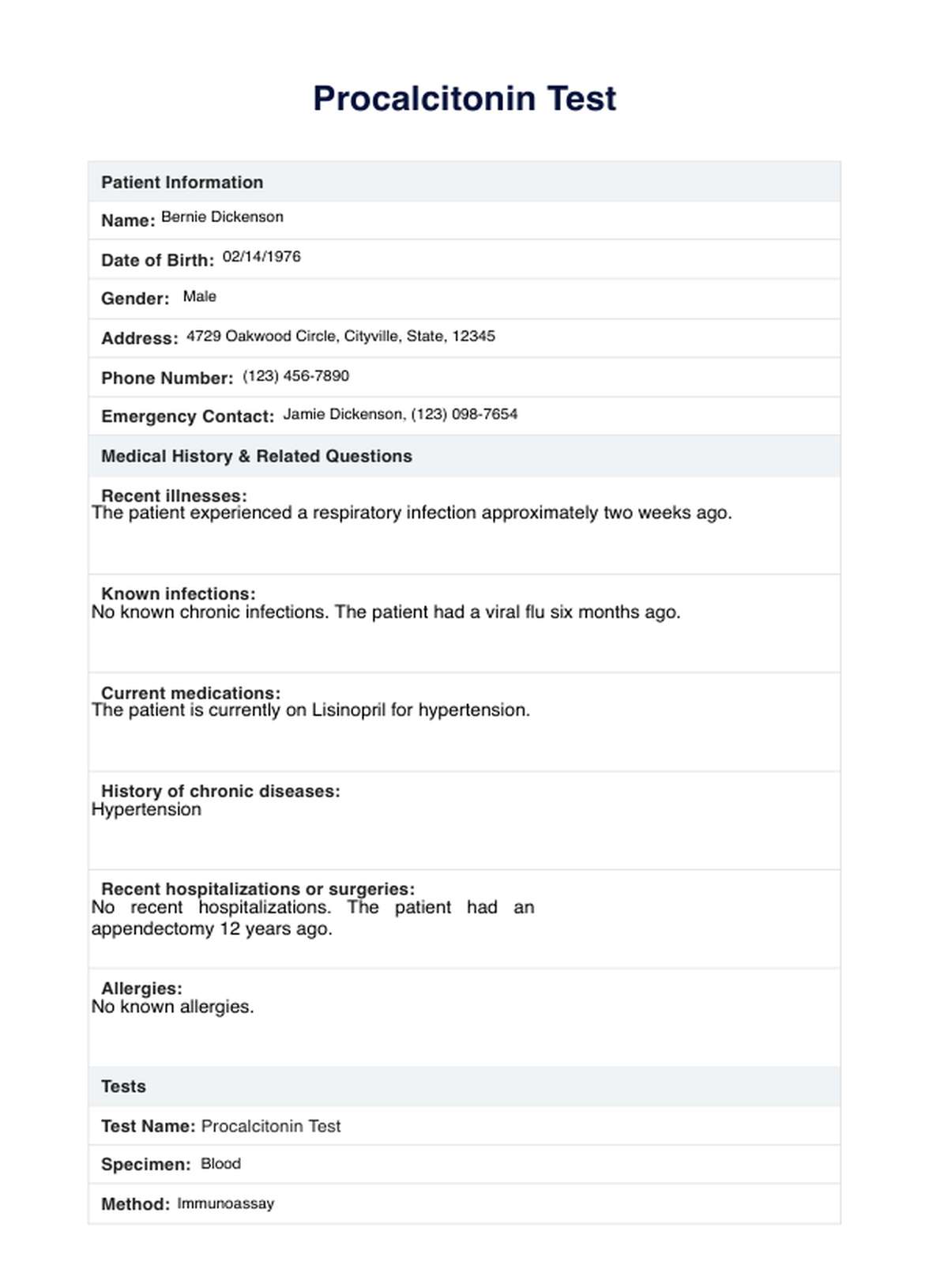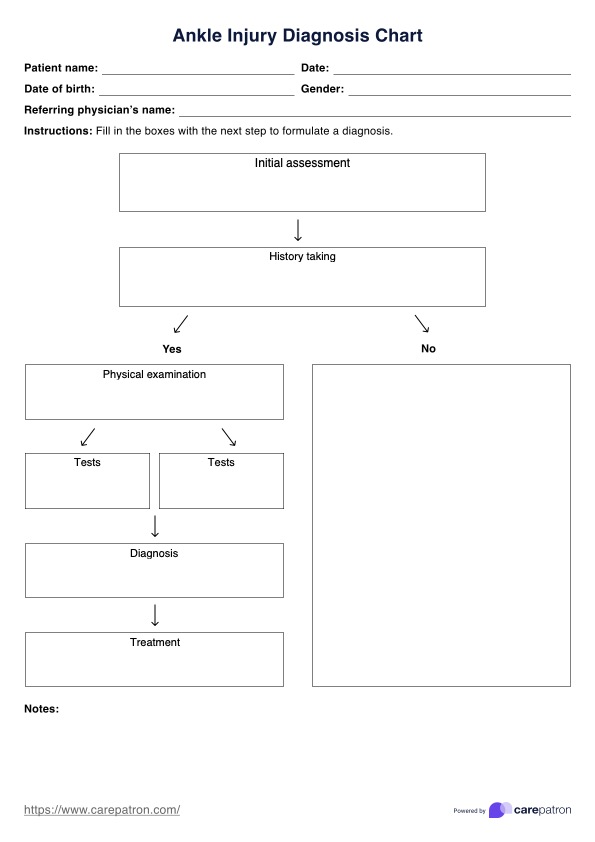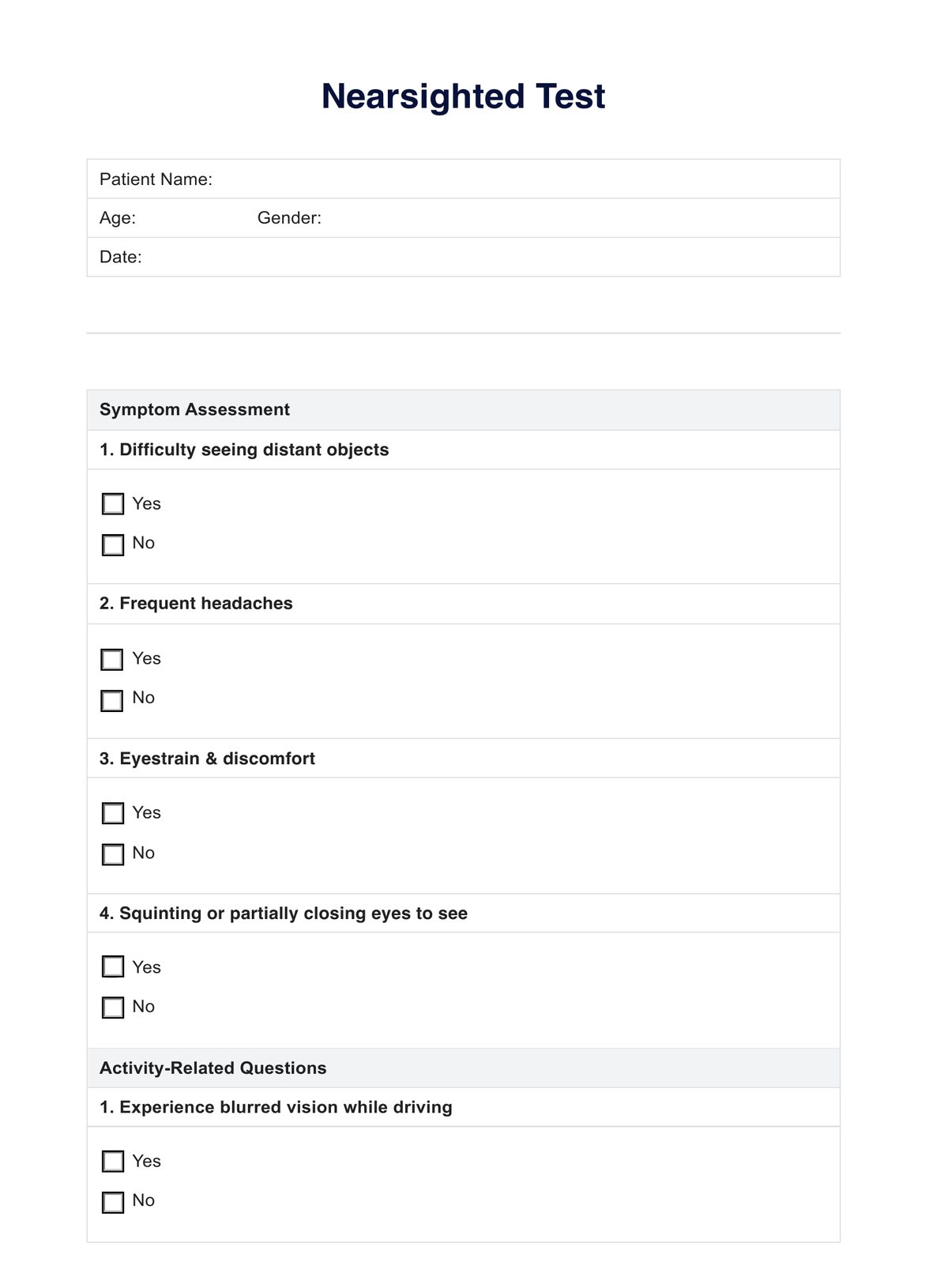Procalcitonin
Unlock efficiency with Carepatron's Procalcitonin App! Seamless integration, real-time updates, and superior data security in healthcare. Join us for excellence!


What Is A Procalcitonin Test?
In medical diagnostics, where precision is non-negotiable, the Procalcitonin Test emerges as a beacon of reliability for healthcare professionals worldwide. But what exactly is this test, and why has it become a cornerstone in the diagnostic toolkit, particularly in the critical care environment?
The Procalcitonin Test is a high-sensitivity blood test renowned for detecting bacterial infections and sepsis, a life-threatening response to infection. Unlike routine blood tests that provide a broad picture, the Procalcitonin Test delves deeper, identifying procalcitonin levels that typically skyrocket during severe bacterial infection. This specificity not only aids in the early detection of sepsis but also significantly guides antibiotic therapy, ensuring a targeted and judicious approach.
In the bustling corridors of healthcare facilities, where every second counts, the rapid responsiveness of the Procalcitonin Test is invaluable. It provides clinicians with the data needed to make informed decisions swiftly, potentially tipping the scales in favor of recovery during the golden hour, especially in critical care.
However, the utility of the Procalcitonin Test isn't confined to emergency scenarios. It's a vigilant sentinel in postoperative care, a reliable ally in intensive care units, and an indispensable resource in combating antibiotic resistance, one of today's most pressing healthcare challenges.
As we venture deeper into this guide, we'll unravel the intricacies of the Procalcitonin Test and explore its profound impact on patient care. From its nuanced application in clinical scenarios to its pivotal role in medical research, this test is more than a procedure; it's a lifeline.
Procalcitonin Template
Procalcitonin Example
How to Use the Procalcitonin Test
Procalcitonin tests are pivotal in modern healthcare, providing crucial data that helps diagnose and manage bacterial infections and sepsis. Here's how healthcare professionals can effectively utilize this test.
Step 1: Assess Patient's Symptoms and History
Evaluate the patient's current symptoms and medical history. Look for signs of infection, such as fever, chills, or other specific symptoms related to the site of infection. Consider recent surgeries, antibiotic use, or other risk factors for bacterial infections.
Step 2: Explain the Test to the Patient
Inform the patient about the procalcitonin test, explaining its purpose in detecting severe bacterial infections and guiding antibiotic therapy. Ensure they understand the procedure and address any concerns they may have.
Step 3: Collect Blood Sample
Using standard venipuncture procedures, collect a blood sample from the patient. Ensure the sample is handled and stored according to required medical standards to maintain its integrity.
Step 4: Analyze the Sample
Send the sample to the laboratory for analysis. The lab will measure the procalcitonin level in the blood, a marker indicating a bacterial infection if elevated.
Step 5: Interpret the Results
Once the results are available, interpret them in the context of the patient's overall clinical picture. Elevated procalcitonin levels suggest a bacterial infection and can guide the decision on antibiotic therapy.
Step 6: Implement a Treatment Plan
Based on the test results and the patient's condition, devise a treatment plan. This may involve initiating or adjusting antibiotic therapy and providing supportive care as needed.
Step 7: Monitor Patient's Response
Continuously monitor the patient's response to treatment. Further procalcitonin tests may be necessary to assess the effectiveness of the treatment and guide decisions on continuing, adjusting, or stopping antibiotic therapy.
The procalcitonin test is a valuable tool in the hands of healthcare professionals. It not only aids in the timely diagnosis of bacterial infections but also in making informed decisions that uphold patient safety and promote optimal health outcomes.
When Would You Use This Form?
In the intricate landscape of medical diagnostics, the Procalcitonin Test emerges as a beacon for healthcare professionals. Its utilization is common but reserved for specific clinical scenarios warranting its insight. Below, we explore how this test becomes an indispensable asset.
- Suspected Bacterial Infection: The primary indication for a procalcitonin test is when there's a suspicion of a severe bacterial infection. Symptoms reflective of sepsis or systemic infection necessitate this test to confirm the diagnosis and initiate prompt treatment.
- Managing Antibiotic Therapy: This test is crucial in guiding antibiotic stewardship. It helps decide whether to start antibiotics in ambiguous cases and, equally importantly, when to discontinue them, preventing unnecessary overuse.
- Differentiating Bacterial from Viral Infections: In respiratory illnesses or meningitis, where symptoms might be ambiguous, procalcitonin levels can help distinguish bacterial causes from viral ones, guiding more targeted treatment.
- Monitoring Treatment Response: In patients already diagnosed with bacterial infections, especially sepsis, repeated procalcitonin measurements can monitor the response to treatment, providing a clear indication of therapeutic effectiveness.
- Postoperative Infections: Patients are monitored for infections after surgery, especially with intensive procedures. A spike in procalcitonin levels could be the first sign of a postoperative infection, prompting immediate intervention.
In conclusion, the Procalcitonin Test is not a routine blood test but a strategic tool deployed in specific clinical contexts. Its judicious use is part of precision medicine that emphasizes the proper intervention at the right time, pivoting to patient-centric care.
What do the Results Mean?
Medical testing is one of nuance and precision, where each result is a piece of a larger health narrative. The Procalcitonin Test, used in detecting and managing certain infections, carries specific interpretations that healthcare professionals must understand.
A procalcitonin test measures the level of procalcitonin in the blood, with results requiring contextual interpretation:
- Normal Levels: Typically, a normal result, which is usually less than 0.1 ng/mL, suggests a low likelihood of a systemic bacterial infection. It's a sign that the body isn't responding to a bacterial invader at a level that necessitates antibiotics.
- Elevated Levels: Higher levels above 0.5 ng/mL indicate a possible bacterial infection. The higher the procalcitonin level, the greater the likelihood of a severe bacterial infection, such as sepsis.
- Critically High Levels: Extremely high levels, especially those above 10 ng/mL, are a critical indicator, often associated with severe systemic infections like sepsis or septic shock. Immediate and aggressive intervention is typically warranted.
It's important to note that procalcitonin levels are just one part of the diagnostic puzzle. These results must be interpreted with clinical observations and other laboratory findings to form a comprehensive view of the patient's health status.
Research & Evidence
The inception and subsequent utilization of the Procalcitonin Test in clinical settings mark significant milestones in medical diagnostics. Initially discovered in the 1980s, this biomarker was identified in patients suffering from bacterial infections and sepsis. Over the years, extensive research and clinical trials have underscored its efficacy.
One of the pivotal research breakthroughs was understanding procalcitonin's role in bacterial infections. Studies revealed that procalcitonin levels rise significantly in response to bacterial toxins and remain low during viral infections, making it a reliable marker for bacterial infections (Schuetz et al., 2013).
Furthermore, the research highlighted its role in antibiotic stewardship. A landmark study demonstrated that antibiotic therapy based on procalcitonin levels reduced antibiotic exposure and side effects without affecting patient outcomes (Bouadma et al., 2010). This evidence was instrumental in incorporating procalcitonin-guided therapy into clinical guidelines.
Recent studies continue to explore procalcitonin's potential in different clinical scenarios, including lower respiratory tract infections and postoperative care, expanding its applicability (Huang et al., 2019).
In conclusion, the Procalcitonin Test stands on a robust foundation of scientific inquiry and evidence-based medicine. Its journey from a novel biomarker to a standard diagnostic tool underscores the relentless pursuit of medical excellence and patient-centered care.
References
- Schuetz, P., Briel, M., Christ-Crain, M., Stolz, D., Bouadma, L., Wolff, M., ... & Mueller, B. (2013). Procalcitonin to guide initiation and duration of antibiotic treatment in acute respiratory infections: an individual patient data meta-analysis. Clinical Infectious Diseases, 57(5), 541-550. Link to Source
- Bouadma, L., Luyt, C. E., Tubach, F., Cracco, C., Alvarez, A., Schwebel, C., ... & Wolff, M. (2010). Use of procalcitonin to reduce patients' exposure to antibiotics in intensive care units (PRORATA trial): a multicentre randomised controlled trial. The Lancet, 375(9713), 463-474. Link to Source
- Huang, D. T., Yealy, D. M., Filbin, M. R., Brown, A. M., Chang, C. H., Doi, Y., ... & Kellum, J. A. (2019). Procalcitonin-guided use of antibiotics for lower respiratory tract infection. The New England Journal of Medicine, 380(26), 2522-2532. Link to Source
Commonly asked questions
Carepatron employs top-tier, HIPAA-compliant security measures to safeguard patient data, ensuring confidentiality and peace of mind for healthcare providers.
Carepatron is designed for interoperability, allowing seamless integration with various electronic health systems to enhance workflow efficiency.
Yes, Carepatron is scalable, catering to the needs of diverse healthcare settings, from private practices to large-scale healthcare facilities, ensuring optimal functionality regardless of size.

















































































































